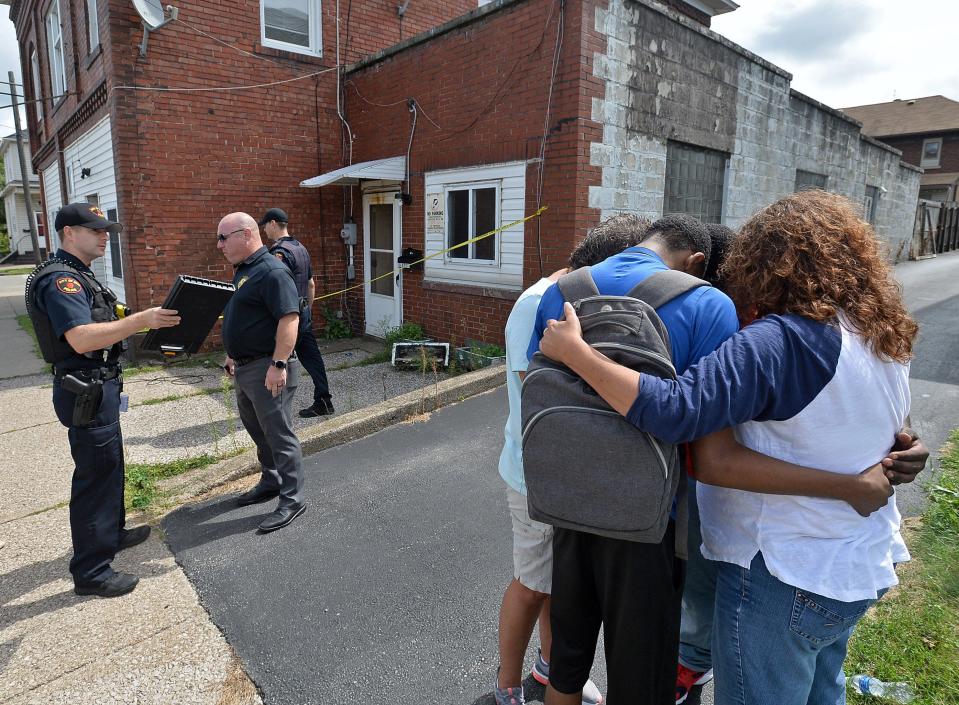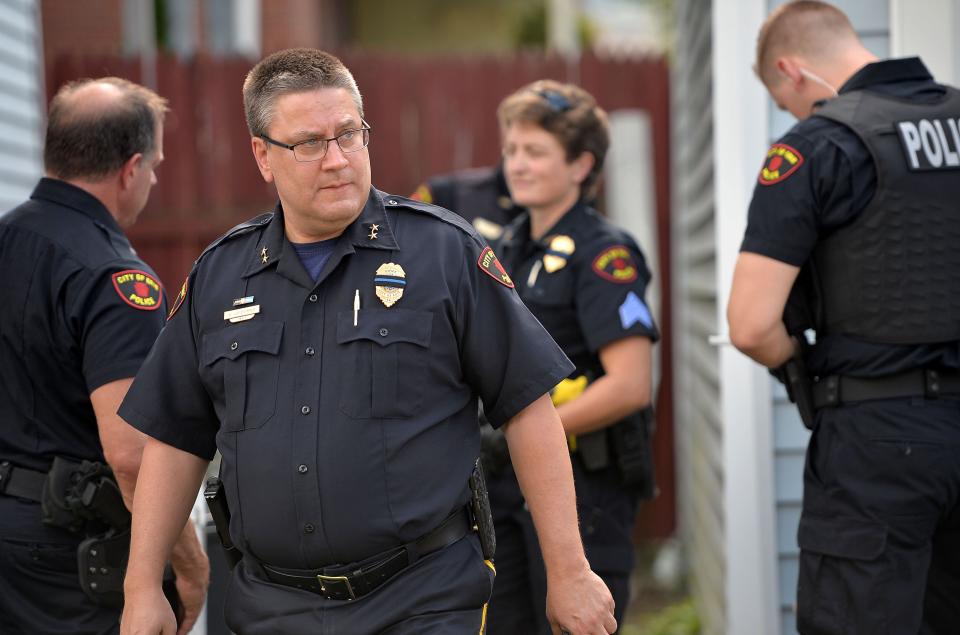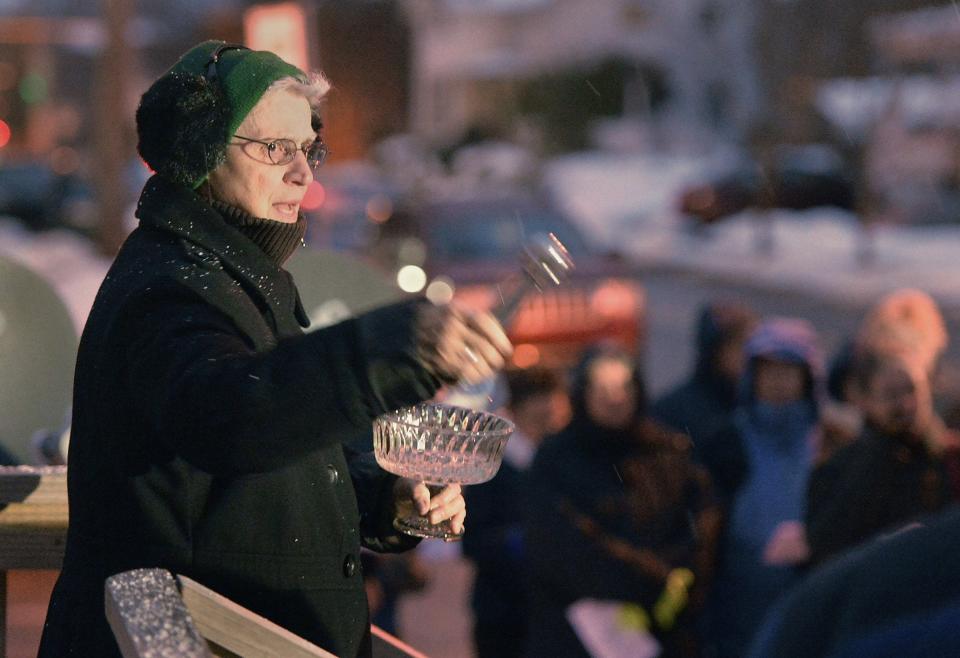Behind a 'remarkable' investigation: How Erie police, DA solved a deadly crime spree
The first indication of the violent crime spree came late in the evening on May 7, 2018. Erie police were called to the scene of a home-invasion robbery in the 600 block of East Fourth Street.
Several people forced their way into a home, robbed a man of cash and a cellphone and shot the 39-year-old victim in the abdomen.
Detectives charged two juveniles as adults in the robbery, but police started getting names of others possibly involved. Those names would become familiar later.
Crime continued to surge in the late spring and summer of 2018.
Robberies of pizza delivery drivers.
Robberies of residents in their homes.
Stabbings.
Assaults.
Shots fired.
Homicides.
One of the killings occurred in late August.
Police went to an apartment at East 26th Street and Pennsylvania Avenue on Aug. 30, 2018. They discovered the body of 24-year-old Calvin Isaiah, a drug dealer who had been fatally shot the night before as he was in bed. His place had been was ransacked, and someone had knocked out ceiling tiles in search of something.
Days later, another drug dealer was found dead.
That victim was Phillip Anthony Clark, 44, who used a wheelchair because he was left paraplegic after he was shot in 1997. He was shot to death on Sept. 4, 2018, as he sat, naked, on the toilet in his apartment in the 300 block of West 29th Street, near Cochran street.
The scene at Clark's apartment was almost identical to the scene at Isaiah's. Both apartments were torn apartment, Erie police Inspector Christopher Janus said in an interview.
"Then we were like, 'Uh oh,'" he said.

Detectives started comparing the two homicides with other recent unsolved violent crimes. One was a home invasion robbery on Sept. 3, 2018, at a residence in the 1100 block of West 20th Street, between Raspberry and Cranberry streets.
Two residents of the house were assaulted and robbed. Someone tried to set the place on fire as the robbers looked for drugs.
"Collectively, we thought it's got to be the same crew," Detective Sgt. Matthew Berarducci said.
It was.
Looking back at a probe that lasted more than 5 years
More than five years after the crime wave started in 2018, three Erie residents were convicted in the two murders, the West 20th Street home-invasion and two other violent incidents in the summer of 2018.
The guilty verdicts, returned in Erie County Common Pleas Court on Nov. 2, ended a two-week trial that involved three defendants and 22 witnesses, making the trial one of the longest and most complex in Erie County in the last several years.
As the lead prosecutor told the nine men and three women on the jury, the evidence in the case was chilling, as were the ages of the defendants when the crimes occurred: 16, 17 and 18.
The evidence showed the three carried out the crimes to rob the drug dealers of drugs and money and to prove themselves on the street. Killing someone — "catching a body" was the slang phrase mentioned at trial — represented the most coveted and twisted rite of passage in what the lead prosecutor called Erie's "grisly underworld."
The evidence also showed that the three defendants — Christopher J. Bridges, then 16 and now 22; Destin A. Dortch, then 17 and now 22; and Raeshawn D. McCallum, then 18 and now 24 — acted with the guidance of an adult.
He is Chinello Blaski, now 43, an admitted drug dealer who was charged along with the three but whose cooperation helped break open the case against them. Under Blaski's tutelage, the three — who did not testify and who put up no defense in court — were portrayed as prodigies of violence who wanted more than anything to prove that they had arrived and established "street cred."
A "gang-style graduation," was how the lead prosecutor, Chief Deputy District Attorney Jeremy Lightner, described the killings and other crimes to the jury.

Using statements from Blaski and another cooperating codefendant, Nicholas Grayson, 32, the police gradually built a case against Bridges, Dortch and McCallum. DNA, fingerprints and social media posts help support what Blaski and Grayson told investigators, but collecting the evidence against the defendants, who were charged in 2021, took lots of patience and lots of time — more than five years from the date of the crimes to the trial.
"A half a decade of investigation. That is remarkable," said Erie County Councilman Andre Horton, the father of murder victim Calvin Isaiah.
Horton and his family sat through the trial. Horton, who is known for speaking out against problems with the police, praised Erie Police Chief Dan Spizarny and his department for their dedication to the investigation into his son's death and the other crimes from 2018.
"Give credit where credit is due," Horton said. "They did a remarkable job of police work."
Horton said he and his family continue to rely on their faith as they deal with the tragedy.
"We are still processing it," he said.
How cooperating defendants helped accelerate investigation
The murders of Isaiah and Clark were not the only crimes Erie police had to deal with in 2018 and 2019. Police had to investigate four more homicides by the end of December 2018, along with four bank robberies, 11 business robberies and a number of shootings and stabbings.
"It was a little overwhelming," Erie police Lt. Michael Hertel said.
Police picked up information on Bridges, Dortch and McCallum as they investigated the other crimes, such as the home-invasion robbery on East Fourth Street in May in which two other juveniles were charged.
A big break in the probe of the 2018 killings occurred in March 2019.
Grayson reached out to police and said he wanted to talk.
Grayson explained that he and Blaski were involved with Bridges, Dortch and McCallum, according to testimony at trial. Grayson also said that he and Blaski had a falling out in the fall of 2018, after the crime spree, and that the two had come to despise each other.

Grayson linked Bridges, Dortch and McCallum to the crew that the police suspected was responsible for the rampage in the summer of 2018. Grayson said he was with Blaski, Dortch and Bridges at the home-invasion robbery on West 20th Street, and he said he had cased Phillip Clark's apartment before he was killed.
The pattern became clear. Police determined that Blaski, Grayson, Bridges, Dortch and McCallum were after "soft targets" — people they knew who sold drugs and had drugs and money and whose own crimes would make them less likely to call police to report that they had been robbed. On the street, robberies of drug dealers were called "licks" or "stings"
Grayson was brought in for questioning.
He told police that he had buried some evidence in the woods in Erie and stored other evidence at his house, Inspector Janus said. Janus said he stopped the interview, and police went to Grayson's house and recovered a .380-caliber handgun.
Police tested the gun, and it matched the ballistics from the Clark homicide and from a shooting at East 23rd and French streets on June 18, 2018.
Investigators interviewed the victim in that case. He was adamant that McCallum shot him in the leg and robbed him of a necklace and a watch. The victim would later testify at trial.
Grayson's information also led police to a wooded area near the Tops supermarket on East 38th Street in Erie. He said the crew had buried two plastic containers there.
Janus said police found an unearthed plastic container in the woods. Scattered on the ground near the container were handcuffs, a mask, keys, a T-shirt, phone parts and two phones belonging to Clark.
Grayson said he had dug up the container the previous fall and removed the .380-caliber gun, Janus said. The other items were left out and exposed to the elements over the winter.
Police searched the area for the second container, but never located it, Janus said. They eventually found it through Blaski.
Police brought him in for an interview about a month after Grayson spoke to investigators. Blaski's interview was a "big day" in the investigation, Lt. Hertel said.
The second container, which Blaski told police he dug up, was a shoebox wrapped in a black garbage bag. It contained ammunition and a sweatshirt that had McCallum's DNA on it, police said.
Blaski offered more information in later interviews, investigators said. He backed what Grayson had told detectives and added details about the murders of Isaiah and Clark.
Police start putting 'the pieces in place'
A key element of the interviews with Blaski and Grayson — and element that Lightner, the lead prosecutor, emphasized when the two testified at trial — was that Blaski and Grayson had come to dislike each other so much that they had not spoken for months.
The two had not gotten together to compare stories about what happened, Lightner told the jury. They independently provided information that was consistent with what the other had told police.
As Lightner also said at trial, the police and prosecution had more evidence than just what Blaski and Grayson said.
Police found Dortch's fingerprints on an exterior window of Isaiah's apartment, which matched what police had learned about Dortch trying to burglarize Isaiah's apartment the day before Isaiah was shot and killed.
Police found McCallum's DNA on an exercise weight that was resting just below the ceiling tiles that had been moved around in Isaiah's apartment — another clue that McCallum and Dortch had tried to rob Isaiah and had searched the apartment for drugs and money.
Police found that Bridges, the other member of the crew, had Isaiah's cellphone after he was killed. And police combed social media and found photos that linked the crew to the crimes. Some of the posts showed Bridges and McCallum with what Lightner at trial described as a rifle in the style of an AR-15 that he said was connected to Blaski.
"We had a lot of pieces in place," said another Erie police investigator on the case, Detective Sgt. Craig Stoker.
The physical evidence found at Isaiah's apartment was a testament to the work of the Erie police's Identification Unit, which spent a week at the scene looking for clues.
Also involved in the entire investigation were the District Attorney's Office and various units of the Pennsylvania State Police. Their assistance to the detectives who made the arrests in the case was invaluable, Janus said.
"We are the names on the affidavits and the people in court, but guys were showing up on the scenes and immediately recognizing things," he said.
The police had less physical evidence linking the crew to Clark's murder. But they had the .380-caliber gun that Grayson had turned over, and they had the statements of Grayson and Blaski. Grayson said he had cased Clark's apartment before the killing, and Blaski said he drove Bridges, Dortch and McCallum to the apartment to rob Clark.
Blaski testified that he drove the three away from Clark's apartment after Clark was killed. He said the three laughed and described how McCallum shot Clark as he was sitting on the toilet, naked, and pleading for his life.
The three said that Bridges' gun had jammed and that Dortch's gun did not work, Blaski testified. He testified he had given Dortch a non-functioning gun.

Blaski and Clark, known as Tony, had been friends, Blaski also testified. He said he had no qualms about targeting Clark for a robbery: "No honor among thieves," Blaski said.
He said he cried and grieved over Clark's death.
"He was a real good person," Blaski testified.
After verdict, family grieves, police continue work
At trial, Lightner spent considerable time deflecting the defense's assertions that Blaski and Grayson could not be trusted. Another challenge for him and the other prosecutors on the case — Nick Maskrey and Emily Downing, both assistant district attorneys — was organizing all the evidence and witnesses to present the sprawling case in a way that jurors could follow.
"It has to be like a movie from start to finish, so the jury knows what is going on," Lightner said in an interview. "That was the hardest part: Trying to tell the story well."
The story is not yet over.
Bridges, Dortch and McCallum are scheduled for sentencing on Jan. 4 before Judge David Ridge, who presided at trial. Dortch and Bridges were prosecuted as adults though they were juveniles when the crimes occurred.
The three, who remain in the Erie County Prison with no bond set, were convicted of all of the more than 60 charges against them.
Dortch will be sentenced for first-degree murder in Isaiah's death, for second-degree murder in Clark's death — based on evidence that he was present at the fatal robbery but did not kill Clark — and for burglary and related charges in the break-in at Isaiah's apartment the day before he was killed.
Bridges will be sentenced for second-degree murder in Clark's death, for burglary and related charges in the break-in at Isaiah's apartment the day before he was killed and for the home-invasion robbery on Sept. 3, 2018.
McCallum will be sentenced for first-degree murder in Clark's death, for burglary and related charges in the break-in at Isaiah's apartment and for the home-invasion robbery. He was also convicted of charges in the shooting at East 23rd and French streets in June 2018.
Blaski and Grayson are awaiting prosecution for their roles in the various crimes.
As those cases proceed, Erie police continue to investigate other major crimes from the summer and fall of 2018 that remain unresolved. Police said those cases include the fatal shooting of 18-year-old Jose Rosario at his Reed Street residence in October 2018.
Another case is the home-invasion robbery in the 600 block of Elm Court, off East Lake Road and just west of Payne Avenue, in September 2018 in which gunfire was exchanged and a dog was shot.
At the sentencings on Jan. 4, the focus will be on the murders of Calvin Isaiah and Phillip Anthony Clark.
Andre Horton said he plans to speak about his son at he hearing.
He said sitting through the trial "was hard for me to do as a parent," and that he will never stop grieving for Isaiah. Horton said he takes solace in that the extended police investigation and the lengthy trial ended the way they did.
"There are no winners here," Horton said. "It is not going to bring my son back. But it is good that someone is going to be held accountable."
Contact Ed Palattella at epalattella@timesnews.com. Follow him on X @ETNpalattella.
Contact Tim Hahn at thahn@timesnews.com. Follow him on X @ETNhahn.
This article originally appeared on Erie Times-News: Police, DA give inside look at how deadly Erie crime spree was solved

